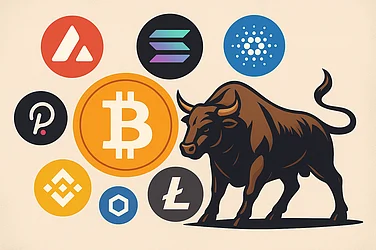With the rapidly evolving Gaming & NFTs sector, innovative mind-sets are continuously unfolding and disrupting how games are being played and engaged with virtual items. Play-and-Own (P&O) is precisely such a new-fangled development that is gaining prominence and turning the conventional "Play-to-Earn" concepts on their heads with a focus on ownership, social sharing, and long-term value creation.
As P2E games centered on economic gain, the Play-and-Own is about taking back players' agency and ownership — enabling them not only to earn but to own their gaming assets. It transcends the play-economics dichotomy, making play a game of engagement, creation, and ownership.
Play-and-Own (P&O) basics
Play-and-Own (P&O) is a new-generation blockchain gaming in which players are rewarded in NFTs and other cryptos that they truly own, sell, and leverage across multiple platforms. Unlike Play-to-Earn, which is all about money rewards, P&O promotes player agency and asset usability.
In simple terms, you play because you love playing the game — and the icing on the cake, you own what you earn.
The Core Philosophy of Play-and-Own
The Play-and-Own model aims to achieve balance between the developers and players and both of them benefit from it. It has three columns:
Real Ownership: Anything that is purchased in a game, whether it is a skin, object, or character, is a digital asset (NFT) owned entirely by the player.
Interoperability: Assets are usually usable in many different games or virtual worlds.
Community-Guided Development: A chance to be involved in the game development as well as the management of the ecosystem.
This is an adult stage in Gaming & NFTs, with developers no longer creating games for returns but for player enthusiasm and collective innovation.
Why Play-and-Own Matters to Contemporary Gaming
Gaming & NFTs has seen explosive growth but is not yet at long-term sustainability. Most of the first Play-to-Earn games failed because they saw their players as money cows, rather than members of a community.
Play-and-Own flips this story on its head. It provides a model that is as committed to time, interaction, and imagination as to investment. Players are not game fans — they're co-creators and proprietors in the digital economy.
Key Benefits of Play-and-Own
Higher Player Engagement: Players are incentivized by enjoyment and long-term value.
Pragmatism with Ownership: NFTs are not tokens—NFTs are practical items in-game.
Cross-Platform Value Potential: NFTs can be re-used across games or even metaverse platforms.
Long-Lasting Ecosystems: Tokenomics equilibrium and real-world usability for longevity of the game.
Community Empowerment: Players dictate updates, expansions, and even governance.
Examples of Play-and-Own Applied in the Real World
Several blockchain games and studios are playing with Play-and-Own mechanics.
Examples are:
Illuvium: Player-owned, decentralized RPG with NFT equipment and creatures owned and resold.
Big Time: Combines high-degree play with NFT ownership without favoring earning.
The Sandbox: Users build, own, and monetize experiences using NFTs and land owning tokens.
These concepts indicate how Gaming & NFTs are no longer "earning platforms" but platforms where pleasure and ownership of the digital coexist.
Challenges within the Play-and-Own Ecosystem
Despite the promise, Play-and-Own has drawbacks:
Regulatory Uncertainty: Governments that are still to define frameworks for Gaming & NFTs, particularly asset ownership and taxation.
Market Volatility: Prices of NFTs and cryptocurrencies go up and down, impacting perceived asset value.
Technical Complexity: Interoperability and access to blockchain is still under development.
User Education: Older gamers are unaware of wallets, tokens, or NFTs.
But while technology and know-how continue to accelerate, those barriers are slowly disappearing as game studios and blockchain coders work together and push the boundaries.
The Future of Play-and-Own in Gaming & NFTs
Play-and-Own is a philosophical revolution — from "play to profit" to "play for purpose." It combines the magic of legacy gaming with blockchain's transparency and ownership benefits.
Some of the emerging trends that will define this ecosystem are:
Convergence of NFTs with AI for adaptive and dynamic assets within the game.
Interoperability between chains, allowing the use of NFTs to be smooth across games.
Player economies, where users can create, rent, or trade in-game assets.
Sustainable tokenomics that lower inflation and speculation within gaming economies.
As more studios adopt Play-and-Own, we’ll likely see a healthier, community-centered future for gaming — one that rewards creativity, fairness, and genuine engagement.
Conclusion
Play-and-Own is a new era for NFTs & Gaming, breaking away from exploitative earning culture towards responsible ownership customs. Players are no longer passive customers but creators determining virtual realms.
In short, Play-and-Own isn't just a business model — it's a movement that reframes playing, earning, and owning in the digital era.
FAQs
Q1. What is Play-and-Own (P&O)?
Play-and-Own (P&O) is a game model where players buy and own virtual assets (e.g., NFTs) that have value in the real world, so they actually own their game properties.
Q2. What is the distinction between Play-to-Earn and Play-and-Own?
Play-to-Earn only emphasizes token reward monetization, whereas Play-and-Own emphasizes gameplay experience, ownership, and play duration.
Q3. Is any Play-and-Own game an NFT-based game?
Yes. P&O is all about NFTs because they offer true ownership and enable asset trading across platforms.
Q4. Why is Play-and-Own significant to the Gaming & NFTs industry?
It is a player-driven, long-term approach which enables community building and value creation rather than short-term speculation gain.
Q5. What is the future of Play-and-Own gaming?
The future will witness greater convergence of NFTs, blockchain, and AI to drive cross-game economies, more engaging experiences, and creation of in-game value in the real world.





















